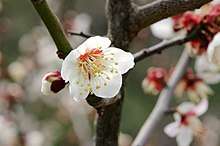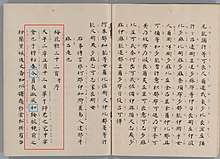Reiwa
Reiwa (Japanese: 令和, pronounced [ɾeːɰa] (![]()
| History of Japan | ||||||||||||||||||||||||||||||||||
|---|---|---|---|---|---|---|---|---|---|---|---|---|---|---|---|---|---|---|---|---|---|---|---|---|---|---|---|---|---|---|---|---|---|---|
b.jpg) Mount Fuji and Tokyo Skytree | ||||||||||||||||||||||||||||||||||
|
List
|
||||||||||||||||||||||||||||||||||
| ||||||||||||||||||||||||||||||||||
.jpg)

Background
Announcement
The Japanese government on 1 April 2019 announced the name during a live televised press conference, as Chief Cabinet Secretary Yoshihide Suga traditionally revealed the kanji calligraphy on a board. Prime Minister Shinzō Abe said that Reiwa represents "a culture being born and nurtured by people coming together beautifully".[4]
Name selection
A shortlist of names for the new era was drawn up by a nine-member expert panel comprising seven men and two women with the cabinet selecting the final name from the shortlist.[5] The nine experts were:[6][4]
- Midori Miyazaki (宮崎緑) – professor at Chiba University of Commerce
- Itsurō Terada (寺田逸郎) – former chief justice of the Supreme Court of Japan
- Shinya Yamanaka (山中伸弥) – Nobel prize-winning stem-cell scientist, professor at Kyoto University
- Mariko Hayashi (林真理子) – screenwriter and novelist
- Sadayuki Sakakibara (榊原定征) – former chairman of the Japan Business Federation
- Kaoru Kamata (鎌田薫) – trustee and president of Waseda University
- Kōjirō Shiraishi (白石興二郎) – president of the Japan Newspaper Publishers and Editors Association
- Ryōichi Ueda (上田良一) – president of the Japan Broadcasting Corporation
- Yoshio Ōkubo (大久保好男) – president of Nippon Television Holdings
The day after the announcement, the government revealed that the other candidate names under consideration had been Eikō (英弘[7]), Kyūka[8] (久化), Kōshi or Kōji[7][9] (広至), Banna or Banwa[7][9] (万和), and Banpo or Banhō[7][9] (万保),[10] three of which were sourced from two Japanese works, the Kojiki and the Nihon Shoki.[11] Official pronunciations and meanings of these names were not released, although the reading of Eikō was leaked; the other readings are speculative.[9] Predicted guess names included An'ei (安永) and Heiwa (平和).[12][13]
.jpg)
Origin and meaning

The kanji characters for Reiwa are derived from the Man'yōshū, an eighth-century (Nara period) anthology of waka poetry. The kotobagaki (headnote) attached to a group of 32 poems (815–846) in Volume 5 of the collection, composed on the occasion of a poetic gathering to view the plum blossoms, reads as follows:
Original Kanbun text: 于時、初春令月、氣淑風和、梅披鏡前之粉、蘭薫珮後之香。[14]
Classical Japanese translation (kanbun kundoku):
時に、初春の令月にして、気淑く風和ぎ、梅は鏡前の粉を披き、蘭は珮後の香を薫す。
Toki ni, shoshun no reigetsu ni shite, kiyoku kaze yawaragi, ume wa kyōzen no ko o hiraki, ran wa haigo no kō o kaorasu.
English translation:
It was in new spring, in a fair (rei) month,
When the air was clear and the wind a gentle (wa) breeze.
Plum flowers blossomed a beauty's charming whiteAnd the fragrance of the orchids was their sweet perfume.
The Japanese Foreign Ministry provided an English-language interpretation of Reiwa as "beautiful harmony", to dispel reports that "Rei" (令) here is translated as "command" or "order"[16][3][17] – which aside from "auspicious" are the more common meanings of the character in modern Japanese and Chinese.[17][18] The Foreign Ministry also noted that "beautiful harmony" is rather an explanation than an official translation or a legally binding interpretation.[17]
Novelty
"Reiwa" marks the first Japanese era name with characters that were taken from Japanese classical literature instead of classic Chinese literature.[4][19][20] The Chinese foreign ministry responded to a question from the Japanese media on this by saying that it is an internal matter for Japan to choose an era name, and expressing good wishes for Sino-Japanese relations.[21]
According to Masaaki Tatsumi (辰巳正明), professor of Japanese literature, and Masaharu Mizukami (水上雅晴), professor of Chinese philosophy, interviewed by the Asahi Shimbun shortly after the announcement was made, the phrase has an earlier source in ancient Chinese literature dating back to the second century AD, on which the Man'yōshū usage is allegedly based:[22]
於是仲春令月,時和氣清;原隰鬱茂,百草茲榮。
Yù shì zhòng chūn lìng yuè, shí hé qì qīng; yuán xí yù mào, bǎi cǎo zī róng.— Zhang Heng, Return to the Field
Then comes young spring, in a fine month,
When the wind is mild and the air clear.
Plains and swamps are overgrown with verdure
And the hundred grasses become rank and thick.— translation by Liu Wu-chi, An Introduction to Chinese Literature (1990)[23]
Robert Campbell, director-general of National Institute of Japanese Literature in Tokyo, provided an official televised interpretation to NHK, regarding the characters based on the poem, noting that "Rei" is an auspicious wave of energy of the plum blossoms carried by the wind, and "Wa", the general character of peace and tranquility.[24]
Accordingly, the name marks the 248th era name designated in Japanese history.[4][25] While the "wa" character 和 has been used in 19 previous era names, the "rei" character 令 has never appeared before.[26] The character appeared in a proposed era name in 1864—Reitoku (令徳)—that the ruling Tokugawa shogunate rejected, as it could be interpreted as the emperor commanding (rei) the Tokugawa.[27]
Implementation
Currency
According to the Japan Mint, which is responsible for producing Japanese currency, all coins with the new era name will be released by October 2019. It takes three months to make preparations such as creating molds in order to input text or pictures. The Mint will prioritize creating 100- and 500-yen coins due to their high mintage and circulation, with an anticipated release by the end of July 2019.[28]
Technology
Anticipating the coming of the new era, in September 2018, the Unicode Consortium reserved a code point (U+32FF ㋿ SQUARE ERA NAME REIWA)[29] for a new glyph which will combine half-width versions of Reiwa's kanji, 令 and 和, into a single character; similar code points exist for earlier era names, including Shōwa (U+337C ㍼ SQUARE ERA NAME SYOUWA) and Heisei (U+337B ㍻ SQUARE ERA NAME HEISEI) periods.[30] The resulting new version of Unicode, 12.1.0, was released on 7 May 2019.[31][32]
Conversion table
To convert any Gregorian calendar year from 2019 to Japanese calendar year in Reiwa era, 2018 needs to be subtracted from the year in question.
| Reiwa | 1 | 2 | 3 | 4 | 5 | 6 | 7 | 8 | 9 | 10 | 11 | 12 | x - 2018 |
|---|---|---|---|---|---|---|---|---|---|---|---|---|---|
| AD | 2019 | 2020 | 2021 | 2022 | 2023 | 2024 | 2025 | 2026 | 2027 | 2028 | 2029 | 2030 | x |
See also
- 2020 in Japan
References
- "新元号「令和(れいわ)」 出典は万葉集" (in Japanese). 1 April 2019. Retrieved 1 April 2019.
- "New Japanese imperial era Reiwa takes name from ancient poetry". Reuters. 2019-04-01. Retrieved 2019-04-01.
- "Government says Reiwa translates as 'beautiful harmony'". The Asahi Shimbun. April 3, 2019.
- "Japan names new imperial era beginning May 1 "Reiwa"". Kyodo News. 1 April 2019. Retrieved 1 April 2019.
- Rich, Motoko (1 April 2019). "Japan's New Era Gets a Name, but No One Can Agree What It Means". The New York Times. Retrieved 1 April 2019.
- "「元号」有識者懇メンバー9人発表 ". Mainichi Shimbun (in Japanese). 1 April 2019. Archived from the original on 1 April 2019. Retrieved 1 April 2019.
- "新元号 6原案中4つは 「英弘」「広至」「万和」「万保」". NHK News Web (in Japanese). 2019-04-02. Retrieved 2019-04-07.
- "Banna, Banpo, Eiko, Koshi and Kyuka: The Japan eras that could have been, beaten out by Reiwa". The Japan Times. 2019-04-03. Retrieved 2019-04-11.
- Baseel, Casey (2019-04-03). "4 era names the gov't rejected before deciding on Reiwa". Japan Today. Retrieved 2019-04-06.
- "新元号 6案すべて判明 「令和」考案は中西進氏か". NHK News Web (in Japanese). 2 April 2019. Retrieved 2 April 2019.
- "「令和」考案は中西進氏 古事記・日本書紀含め、3案が国書典拠" (in Japanese).
- 新元号予想ランキング中間発表!
- 新元号は平和、和平、安久、未来、自由…予想で占う「ポスト平成」
- "真字萬葉集卷第五雜歌0815".
天平二年正月十三日,萃于帥老大伴旅人之宅,申宴會也。于時,初春令月,氣淑風和。梅披鏡前之粉,蘭薰珮後之香。加以,曙嶺移雲,松掛羅而傾蓋,夕岫結霧,鳥封穀而迷林。庭舞新蝶,空歸故鴈。於是,蓋天坐地,促膝飛觴。忘言一室之裏,開衿煙霞之外。淡然自放,快然自足。若非翰苑,何以攄情。請紀落梅之篇,古今夫何異矣。宜賦園梅,聊成短詠。
- "新元号「令和」 首相談話「花を大きく咲かせたい」". Nikkei (in Japanese). 2019-04-01. Retrieved 2019-04-01.
- "Govt.: 'Reiwa' means 'beautiful harmony'". NHK World. April 3, 2019.
- "Japan assures world that Reiwa is all about 'beautiful harmony' and has nothing to do with 'command'". The Japan Times. April 3, 2019.
- The Associated Press (2019-04-03). "Government says Reiwa translates as 'beautiful harmony'". Asahi Shimbun. Retrieved 2019-06-27.
- Osaki, Tomohiro. "Reiwa: Japan reveals name of new era ahead of Emperor's abdication".
- "新元号は「令和」(れいわ) 万葉集典拠、国書由来は初". Asahi News Digital (in Japanese). 2019-04-01. Retrieved 2019-04-02.
- Zhang, Ao (2019-04-01). "日本新年号未出自中国典籍,中方怎么看?外交部这样回应". Global Times (in Chinese). Retrieved 2019-04-02.
- Ozawa, Satoshi (2019-04-01). "「日本が困難な時、万葉集がはやる」 令和は歴史的転換". Asahi News Digital (in Japanese). Retrieved 2019-04-02.
- Liu, Wu-chi (1990). An Introduction to Chinese Literature. Westport, Connecticut: Greenwood Press of Greenwood Publishing Group. p. 54. ISBN 0-313-26703-0.
- "Japanese Literature Expert on New Era Name". NHK World Japan. 1 April 2019. Retrieved 2 April 2019.
- "Japan announces "Reiwa" as new era name to begin under new emperor". Xinhua. 1 April 2019. Retrieved 1 April 2019.
- "Japan's govt. chooses 'Reiwa' as new era name". NHK World Japan. 1 April 2019. Retrieved 1 April 2019.
- The Associated Press (2019-04-03). "Government says Reiwa translates as 'beautiful harmony'". Asahi Shimbun. Retrieved 2019-06-27.
- "「令和」の硬貨はいつ発行される?免許証、書類はどうなる… | ページ 2". bizSPA!フレッシュ (in Japanese). 2019-04-02. Retrieved 2019-04-03.
- Lunde, Ken (1 April 2019). "Adobe-Japan1-7 Published!". CJK Type Blog. Adobe. Retrieved 2 April 2019.
- "New Japanese Era". The Unicode Blog. Unicode Consortium. 2018-09-06. Retrieved 1 April 2019.
- "Unicode Version 12.1 released in support of the Reiwa Era". Unicode Consortium. Retrieved 9 May 2019.
- "Unicode 12.1.0". The Unicode Consortium. Retrieved 2 April 2019.
External links

| Preceded by Heisei (平成) |
Era of Japan Reiwa (令和) 1 May 2019 – present |
Most recent |
